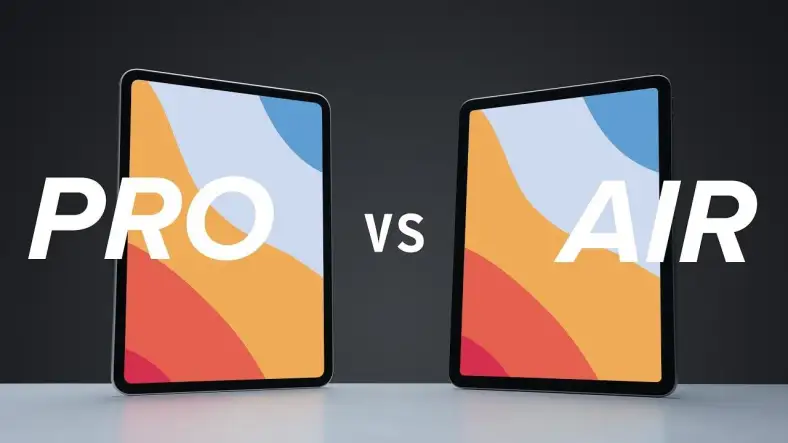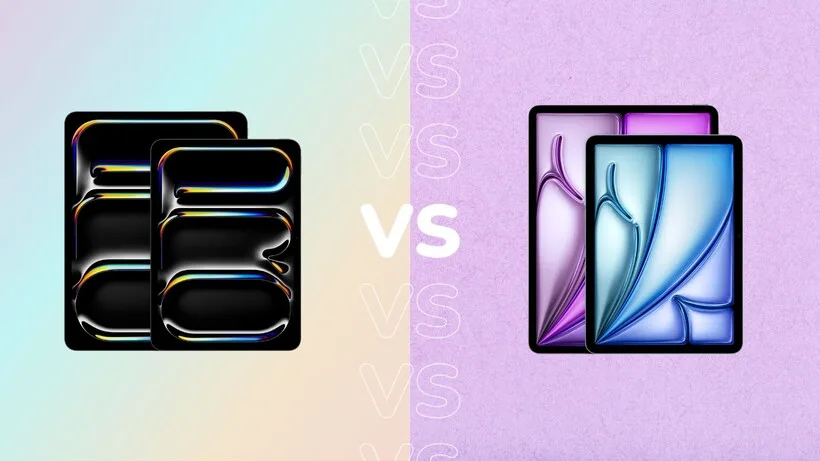Apple’s iPad lineup offers two compelling options: the affordable M3 iPad Air and the premium M5 iPad Pro. With a $400+ price gap, choosing between them requires understanding what you actually need versus what sounds impressive on a spec sheet.
Table of Contents

M3 iPad Air vs M5 iPad Pro: All Differences Compared
The iPad Air received the M3 chip in early 2025, while the iPad Pro jumped to the M5 chip with minimal other changes after 2024’s major OLED redesign. The core question: do you need the Pro’s high-end features, or will the Air’s excellent value suffice?
| Feature | iPad Air (M3) | iPad Pro (M5) |
|---|---|---|
| Display | Liquid Retina LED (IPS) | Ultra Retina XDR (Tandem OLED) |
| Refresh Rate | 60Hz | 120Hz ProMotion |
| Brightness | 500-600 nits SDR | 1,000 nits SDR, 1,600 nits peak HDR |
| Chip | M3 (3nm first-gen) | M5 (3nm third-gen) |
| RAM | 8GB standard | 8GB (256-512GB), 16GB (1-2TB) |
| Authentication | Touch ID (top button) | Face ID |
| Speakers | Two-speaker audio | Four-speaker audio |
| External Display | 60Hz | Up to 120Hz with Adaptive Sync |
| Connectivity | USB-C | Thunderbolt (40 Gbps) |
| Price Difference | Base model | $400+ more expensive |
Best Value vs Best Features
For most users, the iPad Air offers unbeatable value. You get the M3 chip, modern all-screen design, USB-C connectivity, 5G support, and compatibility with Apple Pencil and Magic Keyboard—all without breaking the bank. The 60Hz display and Touch ID work perfectly fine for everyday tasks.
The iPad Pro justifies its premium for professionals needing larger RAM (up to 16GB on 1TB+ models), Thunderbolt connectivity for high-speed transfers, nano-texture display glass for outdoor use, and the stunning 120Hz OLED panel with HDR support reaching 1,600 nits peak brightness. Features like LiDAR and Adaptive Sync remain niche for most buyers.

“Prosumer” buyers wanting the absolute best will appreciate ProMotion’s smoother scrolling, OLED’s deeper blacks and vivid colors, Face ID convenience, and the thinner design, even if not strictly necessary. Learn more about iPad features on Apple’s official site.
Worth noting: a new M4 iPad Air is expected in the first half of 2026 with minimal changes beyond the chip upgrade. If you’re not in a rush, waiting might be wise. For more Apple product comparisons, visit TechnoSports.
Bottom line: buy the iPad Air unless you have specific professional needs or simply want the best regardless of cost. The $400+ premium rarely justifies itself for typical users.
FAQs
What’s the main difference between M3 iPad Air and M5 iPad Pro?
The Pro features 120Hz OLED display, Face ID, Thunderbolt, four-speaker audio, and M5 chip, while the Air offers great value with M3, 60Hz LED, and Touch ID.
Should I wait for the M4 iPad Air?
If you’re not in a hurry, the M4 iPad Air expected in early 2026 will offer better performance at the same price point.








